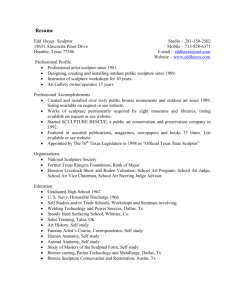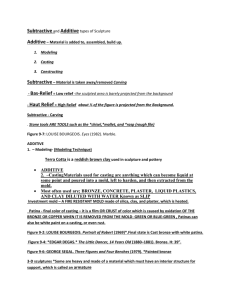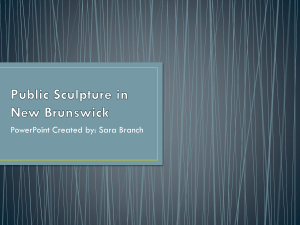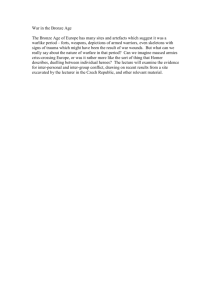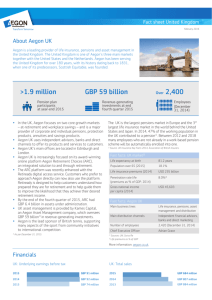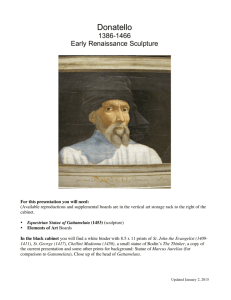- centre.edu
advertisement
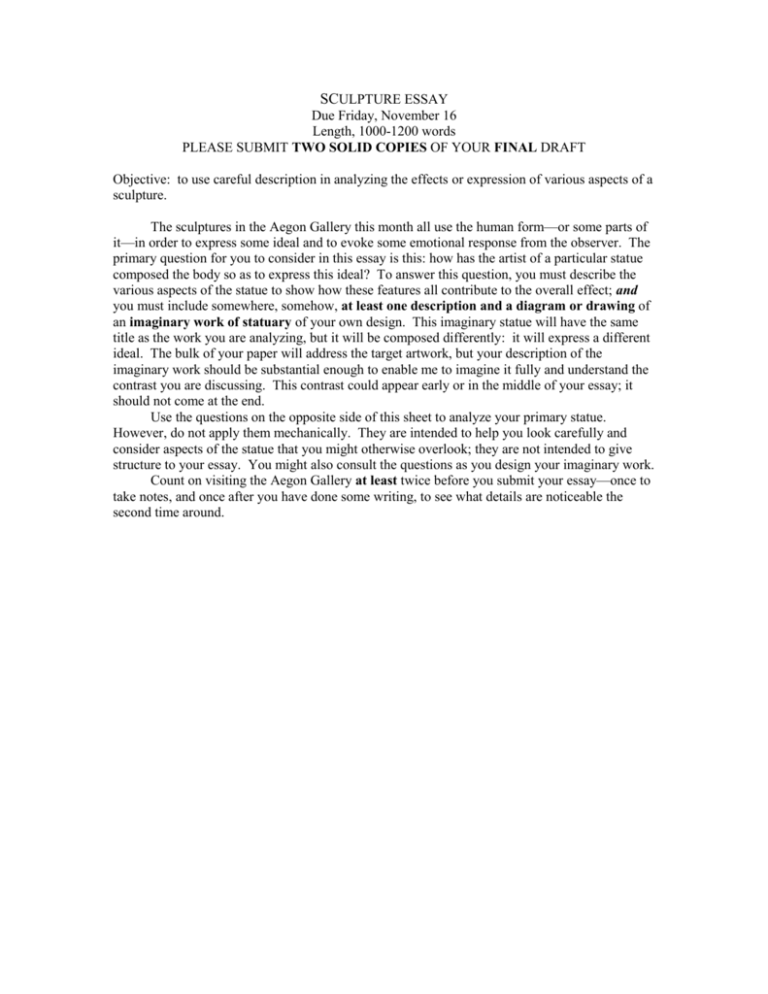
SCULPTURE ESSAY Due Friday, November 16 Length, 1000-1200 words PLEASE SUBMIT TWO SOLID COPIES OF YOUR FINAL DRAFT Objective: to use careful description in analyzing the effects or expression of various aspects of a sculpture. The sculptures in the Aegon Gallery this month all use the human form—or some parts of it—in order to express some ideal and to evoke some emotional response from the observer. The primary question for you to consider in this essay is this: how has the artist of a particular statue composed the body so as to express this ideal? To answer this question, you must describe the various aspects of the statue to show how these features all contribute to the overall effect; and you must include somewhere, somehow, at least one description and a diagram or drawing of an imaginary work of statuary of your own design. This imaginary statue will have the same title as the work you are analyzing, but it will be composed differently: it will express a different ideal. The bulk of your paper will address the target artwork, but your description of the imaginary work should be substantial enough to enable me to imagine it fully and understand the contrast you are discussing. This contrast could appear early or in the middle of your essay; it should not come at the end. Use the questions on the opposite side of this sheet to analyze your primary statue. However, do not apply them mechanically. They are intended to help you look carefully and consider aspects of the statue that you might otherwise overlook; they are not intended to give structure to your essay. You might also consult the questions as you design your imaginary work. Count on visiting the Aegon Gallery at least twice before you submit your essay—once to take notes, and once after you have done some writing, to see what details are noticeable the second time around. VENUS DE MILO Artist unknown Bronze, reduced copy of a Hellenistic original 2nd C. B.C. FLYING MERCURY After Giovanni Bologna (1529-1608) Bronze, height 39 ½” (Reduced copy of a 16th C. original, height 69 5/8”) A VICTOR AT THE COCKFIGHT Jean-Alexandre-Joseph Falguiere (1831-1900) Bronze, 1864, height 16 ¼” SPARTACUS BREAKING HIS CHAINS Denis Foyatier (1793-1863) Bronze, 1827, height 16 ¼” APOLLO BELVEDERE After a work by Leochares, c. 320 B.C. Bronze, modern casting, height 21” THE SNAKE CHARMER Baron Charles Arthur Bourgeois (1838-1886) Bronze, 1862, height 41” Note: the Aegon Gallery is open Monday through Friday, 9-4. Please do not touch the statues. Some Questions to Help You Begin Visual Analysis. 1. What is the position of the figure? How are its arms composed (if any)? its legs? head? Are body parts visible or shadowed? Does the figure seem comfortable or contorted? Do you get an impression of breathing or other signs of animation? 2. Does the composition seem stable or unstable? Is the figure fixed or in movement? 3. If it is in the round, move about the sculpture, studying its successive silhouettes. Are they open or closed? As you move, does the silhouette change subtly or dramatically? Are there preferred views? 4. Do you get a substantially different impression from different silhouettes? 5. Does the sculpture activate the space around it, or is it self-contained? That is, does it seem to participate in our world? 6. Have the surfaces been specially treated to receive or repel light? 7. In what way is light essential to the total visual effect? Where are the shadows? 8. What are the dominant types of line and form? How do lines and forms contribute to the emotional impact of the work? Do the lines control the movement of your eyes? Do they determine the primary focal areas of the sculpture? 9. What is the relationship of the sculpture to its base? to the ground? Does the base share qualities with the form above it?

